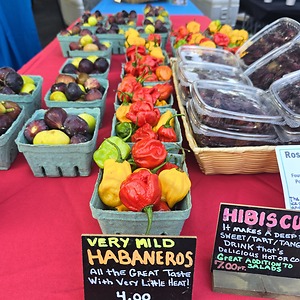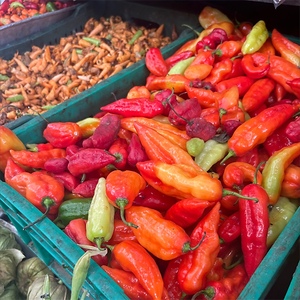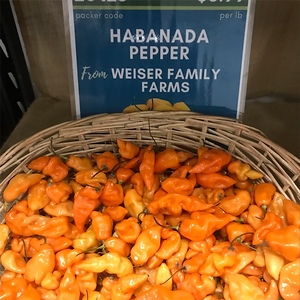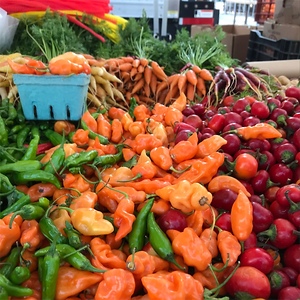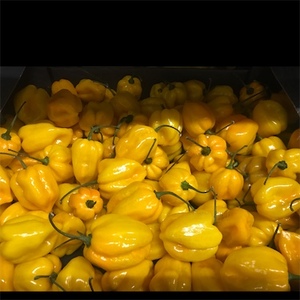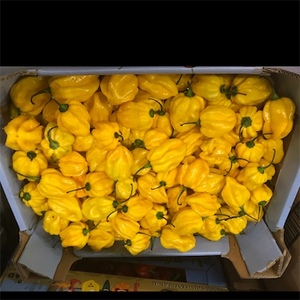

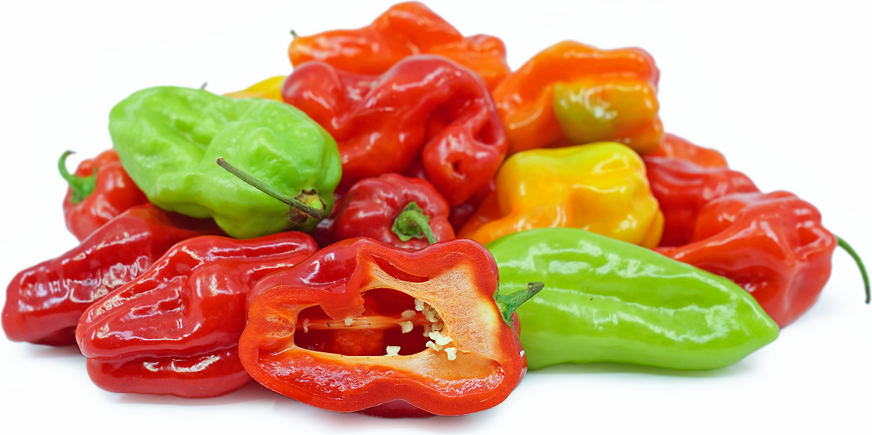
Sweet Habanero Chile Peppers
Estimated Inventory, lb : 0
Description/Taste
Sweet habanero chile peppers are small, lantern-shaped pods, averaging 5 to 7 centimeters in length and 2 to 5 centimeters in diameter, and have many indentations, folds, and creases on the surface tapering to a point on the non-stem end. The skin is waxy, glossy, and smooth, ripening from green to bright red or orange when mature. Underneath the surface, the flesh is thin, crisp, pale red, green, or orange, depending on maturity and encases a central cavity filled with round and flat, cream-colored seeds. Sweet habanero chile peppers have a fruity, floral, and sweet flavor with little to no heat.
Seasons/Availability
Sweet habanero peppers are available in the summer through fall.
Current Facts
Sweet habanero peppers, botanically classified as Capsicum chinense, are hybrid peppers that belong to the Solanaceae or nightshade family. The peppers are nearly identical to the popular spicy, habanero peppers in both appearance, fruity flavors, and aroma, but they lack the scorching spice content that some consumers may consider to be overpowering. There are many different varieties of Sweet habanero peppers, including Suave Orange, Suave Red, TAM mild habanero, Habanada, Honey Zepper, and the peppers average a rating of 850 SHU or less on the Scoville scale. Sweet habanero peppers are favored for their fruity, floral, sweet, and mild flavor and are widely versatile in both fresh and cooked culinary applications.
Nutritional Value
Sweet habanero peppers are an excellent source of potassium and vitamins A and C, which are antioxidants that can help improve the skin, boost the immune system, and protect against environmental aggressors.
Applications
Sweet habanero chile peppers are best suited for both raw and cooked applications such as roasting, simmering, braising, and baking. The peppers can be chopped into salsas, tossed into salads, minced into sauces and marinades, or consumed fresh, out-of-hand as the floral, citrusy flavor can be enjoyed without the intense spiciness. Sweet habanero chile peppers can also be stuffed with meat, breadcrumbs, or cheese and baked, mixed into ceviche, roasted and added to tacos, or served alongside braised meats. Sweet habanero chile peppers pair well with cherry tomatoes, red onion, avocado, mango, cucumbers, cilantro, mint, lime juice, orange juice, queso fresco, seafood, and meats such as poultry, beef, and pork. The fresh peppers will keep up to one week when stored whole and unwashed in a plastic bag in the refrigerator.
Ethnic/Cultural Info
In 2014, one variety of Sweet habanero known as the Habanada was the star fruit featured at the Culinary Breeding Network Variety Showcase. Developed by breeder Michael Mazourek at Cornell University, Mazourek desired to create a version of the habanero with only the fruity and floral flavor to share it with his friends and family who don’t appreciate spicy foods. At the Culinary Breeding Network Variety Showcase, which is an event that highlights unique varieties of produce and pairs these items with chefs to create innovative dishes, Habanada peppers were paired with chef Nora Antene of the Le Pigeon restaurant in Portland, Oregon. Antene savored the pronounced sweet flavors and decided to create a Habanada sherbet to highlight the floral and fruit-forward notes. The sweet and floral dessert quickly became one of the most popular items created at the event.
Geography/History
Sweet habanero peppers are descendants of peppers grown in the Southwestern United States, but many of the sweet varieties have different histories depending on their breeder. In fact, three mild habanero pepper varieties were released in the early 2000s. In 1998, a researcher at the New Mexico Capsicum Accession Germplasm Repository received seeds from an anonymous source, and the seeds were grown in trials at the Chile Pepper Institute in Las Cruces, New Mexico. After a few generations, the seeds were ready for release in 2002 under the name NuMex Suave Orange. Suave is a Spanish term for smooth or mellow, which is a reference to the mild nature of the pepper. Around the same time, the Texas Agricultural Experiment Station was crossing a Yucatan habanero with seed obtained from the USDA Plant Introduction Station in Griffin, Georgia. After five years of cross-breeding, back-breeding, and growing in test fields, another mild habanero was released, called the TAM mild habanero. Michael Mazourek created the Habanada variety at Cornell University through multiple generations of cross-breeding, and the pepper was released to the market in 2007. Today Sweet habaneros are cultivated through select farms and distributors across the United States and can be found through farmers markets and specialty grocers.



